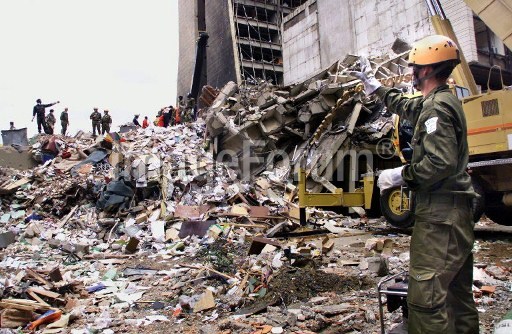In 1998, approximately two hours since I had passed the front gate of the United States (US) Embassy in Nairobi, a huge blast ripped through the building at 10.35AM.
The embassy was situated next to the busy road that I would take every day to and from journalism school. The bomb was targeted at the US embassy, but Ufundi House next door, which houses small offices and a secretarial college, took the brunt of the explosion.
The journalism school was about five kilometers away from the city center and I remember being in a usual morning lecture when I heard a loud bang.
Being young and curious, we rushed to the scene of the blast where rescue workers were trying desperately to dig their way into the wreckage to reach dozens of people trapped inside.
The blast had almost leveled the five-storey Ufundi House and caused extensive damage to the embassy. The scene was chaotic, people running in all directions. The roads were even more chaotic, cars driving in the wrong lanes with their lights on. People who did not know what had happened thought that the government had been overthrown and there was heavy fighting in the city center.
Loading...
Nairobi was in mayhem. What do you do? Where do you start from? Who do you call? I had two brothers and a sister in Nairobi but there was no way of reaching them, telephones were down and transport was non-existent. I felt helpless and horrified.
Back at the scene, a lady covered in blood tells her story to the media.
“I heard a loud bang then the whole place was shaking and within a split second glass was falling on my head,” she said.
Ambulances, firefighters, army and police frantically attended to bodies, both dead and injured, burnt buses and cars, and damaged buildings. It is a scene that has stayed with me for a very long time. The first question that I asked myself was, ‘What did we do to deserve such a violent attack?’
As a dense plume of smoke soared above the skyline, hundreds of people fled the scene while thousands rushed towards it to see what had happened. The city quickly became logjammed, causing further problems for ambulances and rescue workers.
The charred bodies lay in the street near mannequins blown out of nearby shop windows. Scores of people were seen covered in blood from injuries caused by flying glass.
After spending four hours at the scene, I picked myself up and started walking home. Along the way, information started coming through. The death toll was 207 Kenyans and 12 US citizens. More than 1,000 had been injured.
In the blink of an eye, the Al Qaeda terrorist group announced its presence in East Africa, and brought the group’s leader Osama Bin Laden to the attention of the US government.
Terrorism has taken another dimension since then. Kenya’s security forces have struggled to contain an evolving terrorist threat and much of the focus has been on Somalia’s Al-Qaeda-linked Al-Shabaab militants, who use Kenya to seek out new recruits and financing.
Loading...
